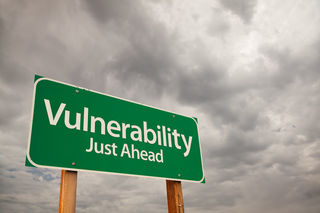OCD
The Best TED Talks for People With OCD: Part 4
Why exposure therapy for OCD could also be called “vulnerability therapy.”
Posted December 11, 2018
What is your OCD’s #1 goal for your life? Is it to gain control? Avoid discomfort? Find that ever-elusive certainty about whatever it is it’s worried about? Well, yes, it definitely wants all those things, but only as stepping stones to its bigger goal. Because what OCD really wants is for you to be invulnerable.
The dictionary definition of invulnerable is “impossible to harm or damage.” Achieving invulnerability is also (ironically) impossible, but that doesn’t make it any less of a fetching prize for your OCD.
Which is why the penultimate installment in this blog series is about Brené Brown’s two TED Talks: "The power of vulnerability" and "Listening to shame." Because embracing vulnerability and understanding how to handle shame are crucial if you want to win your life back from OCD.
Shame is the fear of disconnection
In her first talk, Brené defines shame as “the fear of disconnection.” In her second talk, she goes even deeper, saying guilt is “I'm sorry. I made a mistake,” and shame is “I'm sorry. I am a mistake.”
Everyone with OCD understands shame at a visceral level. Shame is why we won’t tell our families the content of our intrusive thoughts, lest they think that we are monsters. Shame is why we put off getting help, because how could we ever explain those monstrous thoughts without getting carted off to jail or being deemed unfit to interact with the rest of society? Shame is one of the reasons why we get stuck in the soul-draining loop of compulsive behavior, because we are fervently hoping the compulsions will turn off those malevolent thoughts that say night and day, day and night, that we are bad, bad, bad.
One of the core foundations of my OCD’s Rule #1—the rule that I couldn’t tell anyone anything about what was going on in my head—was shame. It’s why I followed Rule #1 faithfully for decades. And shame is why I, at a very young age, started going on a Quest: for distraction from my thoughts and perfection in my behavior that would hopefully result in absolution that I was somehow okay.
Taking off the armor
Rule #1 is all about hiding ourselves from others because shame makes us want to hide. Oftentimes we try to do so by embarking on a Quest like the one I described above, armoring ourselves up with a shield of perfection. Brené described this metaphor in an interview with Oprah several years ago as follows: “If I look perfect, live perfect, work perfect, I can avoid or minimize criticism, blame, and ridicule. All perfectionism is is the 20-ton shield that we carry around hoping that it will keep us from being hurt.” But hiding from others, whether it’s through perfectionism, isolation, or avoidance just feeds your OCD and leads to the very thing we all fear: disconnection.
Brené says in her first talk, “in order for connection to happen, we have to allow ourselves to be seen, really seen.” Have you ever noticed that when you’re with someone and you share a struggle, something you’re going through that’s really hard, that the person you’ve shared it with will then share something that she’s been struggling with? When we decide to take off that armor of invulnerability with a trusted friend, that person almost invariably takes hers off, too. After all, it’s hard to connect through all that armor, but much easier when both parties take it off and share their authentic selves.
What can you do to loosen OCD’s grip of shame? Break Rule #1 and share what you’re going through with someone you trust. Brené says in her second talk, “empathy's the antidote to shame. If you put shame in a Petri dish, it needs three things to grow exponentially: secrecy, silence, and judgment. If you put the same amount in a Petri dish and douse it with empathy, it can't survive. The two most powerful words when we're in struggle: me too.”
I was recently a guest on Your Anxiety Toolkit podcast with Kimberley Quinlan, LMFT to discuss the topic of Sharing Your Mental Health Story, so if you’d like some tips on talking with others about your OCD, check out Your Anxiety Toolkit Episode 78.
What is vulnerability?

Vulnerability has unfortunately had some PR issues. “Why would I want to be vulnerable?” you might ask. “Wouldn’t that mean that I was making myself weak?”
Nothing could be further from the truth, especially for those of us with OCD.
Brené says in her second talk, “Vulnerability is not weakness. I define vulnerability as emotional risk, exposure, uncertainty.” Let’s pull apart this definition to understand what she’s saying about vulnerability when it comes to OCD.
“Emotional risk” means being willing to experience uncomfortable emotions, to feel things that aren’t pleasant or easy. In contrast, OCD is all about emotional numbing: “Let’s do that compulsion so that we can get rid of that anxiety!” says your OCD. But Brené tells us in her first talk that, “you cannot selectively numb emotion.” By trying to get rid of anxiety, we end up squelching all emotional experiences, positive and negative, taking the subtle spice out of life.
The next part, “exposure,” means putting down that shield of perfection and giving up the search for control. OCD is trying to convince you that if you do compulsions, you are somehow going to change outcomes and keep bad things from happening. It’s as if OCD is offering you some sort of magic wand that can alter the past or create a different future, all in the blink of an eye! If you wave that magic (but ultimately ineffective) wand by doing compulsions, well, then you’ve unfortunately been tricked into helping OCD in its futile crusade for control.
Then there’s the last part of the definition: uncertainty. OCD is based on intolerance of uncertainty. It craves certainty like a man stranded on the ocean in a rowboat yearning for fresh water. But if you give into compulsions, leaning over the edge of the boat to quench OCD’s thirst with water from the sea, you will only leave it gasping for more of what it can’t have. Because other than death and taxes, there really is no certainty.
Exposure and response prevention therapy is really vulnerability therapy
Vulnerability is the opposite of OCD. It’s opening yourself up to discomfort. It’s letting go of control. It’s embracing uncertainty. And that is the very definition of exposure and response prevention therapy (ERP), the evidence-based treatment for OCD.
In essence, when you do exposure therapy, you are building your capacity to be vulnerable. And that is making you stronger, not weaker. When you can face tough emotions, accept the way things are, and lean into the unknown, you are embracing vulnerability in all its power. To quote Brené from "Listening to shame":
“Vulnerability is not weakness. I define vulnerability as emotional risk, exposure, uncertainty. It fuels our daily lives. And I've come to the belief—this is my 12th year doing this research—that vulnerability is our most accurate measurement of courage—to be vulnerable, to let ourselves be seen, to be honest.”
That’s why I think of ERP as vulnerability therapy. And the people who go through ERP? Well, they are some of the most courageous people I know. The only one who will come out weaker after exposure therapy is your OCD.
For notifications of new blog posts as well as OCD-taming tips & resources, sign up for my Shoulders Back! newsletter.




